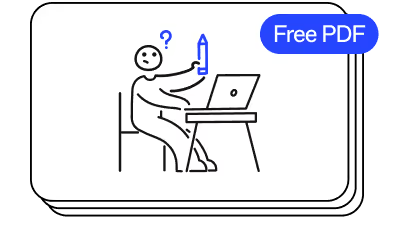How performance improvement plans help struggling employees
%202.avif)
Addressing poor performance template

An employee is dragging their heels, missing deadlines, and putting a strain on everyone’s workloads. How can you get them on the right track?
Performance improvement plans (PIPs) help communicate what’s wrong with an employee’s work and plot a road to recovery. They’re often seen as the final step before termination, but when done right, they offer a second chance at success.
In this guide, we break down the purpose of PIPs, outline best practices, and show you how to set measurable goals that drive change.
What is a performance improvement plan?
A PIP is a document detailing where an employee isn’t meeting expectations and what they could do better. It outlines specific areas that need improvement, offers constructive feedback, and sets measurable goals against clear timelines.
The idea is to try to get the employee back on track before considering termination.
Performance development plans vs. performance reviews vs. performance improvement plans
Performance development plans help workers identify their career goals and set targets to stay on target. Performance reviews are a semi-frequent evaluation of employees’ work to ensure they’re performing as expected. Both are fairly routine and don’t inherently mean anything is wrong.
A PIP, however, is a recognition of failure to meet expectations. While not itself part of the disciplinary process, it can often accompany a formal reprimand. If an employee wants to continue at the company, hitting a PIP's performance improvement targets is crucial.
How to write a performance improvement plan
An effective PIP includes these five elements:
1. Performance issues
The first step is laying out how the employee is falling short. Common examples include missed deadlines, inconsistent productivity, or recurring errors. The goal is to make the gap between current performance and expectations clear.
2. SMART goal setting
After highlighting shortcomings, managers should work to set achievable targets for the employee. The SMART (specific, measurable, achievable, relevant, and time-bound) framework is designed to help managers set realistic objectives, so it’s a great starting point.
3. A clear timeline
Given the importance of employees hitting their targets, the timeline of these objectives must be fair and realistic. Asking them to turn things around too quickly is just setting them up for failure.
Most PIP timelines range from 30 to 90 days, depending on how complex the issues are.
4. Help and resources
It’s important that employees believe leadership wants them to succeed. Offering support through the process helps them feel more secure and confident as they enact changes. This might include mentorship or training and skills development. Providing these resources demonstrates that leadership is invested in the employee’s growth.
5. Feedback and monitoring
Successful PIPs rely on ongoing communication. Check in with the employee regularly to maintain momentum and determine if additional support is required.
The very fact that they’re on an improvement plan means the worker is aware of their shortcomings. This is especially the case if they have also received a formal reprimand. So rather than offering further scrutiny, focus on providing constructive, open feedback. Consistent monitoring also helps you identify wins and blockers throughout the process.
Workleap Performance makes it easy to stay ahead of performance issues by prioritizing constant feedback and building flexible review cycles with 360 feedback reporting. With Workleap AI embedded in the tool, you can also identify trends early, helping address concerns before PIPs are even required.
5 benefits of employee performance improvement plans
A PIP can be a catalyst that turns around periods of poor performance. Here are five ways they benefit employees.
1. They give employees a chance to improve
While a PIP often accompanies formal discipline, the document itself shouldn’t act as a warning or reprimand. It’s a second chance for underperforming employees to get back on track. Plans also provide a record of improvement, allowing managers to recognize employees for successful upskilling efforts. And if employees fail to improve, PIPs provide documentation that companies tried every alternative before termination.
2. They reduce turnover
Recruiting, onboarding, and training costs add up fast. According to the Work Institute, the financial impact of turnover is 33% of an employee’s base pay. It’s often much more cost-effective to focus on improving a struggling worker’s performance than hiring a replacement.
3. They encourage clear communication
Conversations around PIPs offer employees a chance to talk openly about how and why they’re struggling. Many performance challenges stem from misalignment and misunderstandings, but clear, structured frameworks plot out a route for success.
4. They set clear performance standards
SMART goal-setting removes ambiguity from tasks and expectations, so employees know exactly what they need to do and how. Clear performance standards in these plans also boost accountability, since workers can see where to focus their improvement efforts.
5. They ensure accountability and fair process
If an employee’s performance doesn’t improve and termination is necessary, PIPs demonstrate that all necessary steps were taken. A well-structured plan also proves that termination decisions were made based on facts.
Effective performance improvement plans: 10 best practices
Use these 10 best practices to help write effective PIPs that revitalize employees’ prospects.
1. Address the root causes
Instead of just highlighting points of failure, dig deeper to decipher why they’re happening. For example, if an employee frequently misses deadlines, ask whether their workload is unrealistic or if they’re lacking relevant skills.
Identifying the root causes of underperformance helps make action plans realistic and effective. Bonus: employee feels understood rather than set up to fail.
2. Focus on the future
An employee might be able to knuckle down and start hitting a few targets throughout the PIP period, but unless they make meaningful changes to their workflow, they’ll likely end up in the same boat soon after. PIPs should be forward-looking. Ensure an employee doesn’t fall short again by discussing their strengths and weaknesses and establishing long-term development objectives.
3. Don’t be ambiguous
Let employees know exactly what’s expected of them, from standards of work to behavioral adjustments. Vague objectives like “improve productivity” aren’t actionable. Set targets with a clear and measurable success metric.
4. Provide ongoing feedback
Don’t wait until the end of the process to tell workers how they’re doing. Offering employees regular, targeted feedback helps them engage with the improvement process. It’ll also help identify where they need more support to help the plan succeed.
5. Stick to the timeline
Since this is a serious period of measurement, it’s important to establish a fair timeline for the PIP and stick to it. Timelines that are too long can make the employee feel like they’re in limbo, but ones that are too short mean they won’t be able to demonstrate significant improvements.
6. Offer support via resources and tools
Consider what employees need to succeed, whether that’s training, self-assessment templates, mentorship, or work adjustments, and provide it. With the right support, an action plan can go from overwhelming to achievable.
7. Celebrate accomplishments
Big wins deserve high fives, and small wins matter, too. Did your employee meet a deadline? Or did they submit higher-quality work? No matter what the accomplishment is, recognize it. Celebrating like this boosts morale and shows the employee that they’re making progress.
8. Make a decision
Resolve to make a firm decision on the employee’s prospects at the end of the performance improvement period. If they hit their goals, celebrate with them, but if they didn’t, follow through on the agreed-upon consequences.
9. Follow up afterwards
After the improvement period, encourage employees to reach out if they feel their performance slipping. Performance reviews are the perfect time for these conversations. If you want to apply this at work, check out our webinar recap on how to transform performance reviews into meaningful follow-up conversations.
10. Use Workleap AI
Crafting better PIPs starts with better performance reviews. Regular, thorough reviews highlight trends in the employee’s work and allow them to discuss what they’re having difficulty with. If a PIP becomes necessary, these recorded conversations can be used to draft personalized targets and methods of improvement.
Workleap Performance, powered by Workleap AI, streamlines the whole review process, saving time while following HR best practices. Here’s how:
- Performance review summaries: Automatically analyze and condense peer feedback into concise summaries. This makes it easier to spot patterns and coach employees effectively.
- Performance cycle design: Create an entire performance review cycle in minutes with the Review Cycle Builder. Workleap AI ensures cycles align with business needs using built-in HR guidance.
- Feedback assistance: Manage performance reviews from start to finish with smart prompts. They’ll help with providing clear, constructive feedback, meaning less time formatting and more time coaching.
- Work improvement plan templates: Use Workleap’s 1:1 template to identify areas of poor performance. From here, build targeted action plans suited to employees’ needs.
Build more effective performance improvement plans with Workleap AI
Addressing poor performance is never pleasant, but improvement plans offer a chance for a fresh start. When built thoughtfully, they set clear expectations, offer support, and create space for your employee to grow.
Workleap AI uses employee data to help managers give better feedback and visualize performance metrics. It highlights areas for improvement and suggests targeted coaching tips, making it an excellent tool to turn performance reviews into action plans and action plans into real progress.
Explore how Workleap can improve employee performance by requesting a demo today.
Career development plan template


%20(1).avif)


.avif)
.avif)






.avif)
